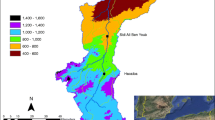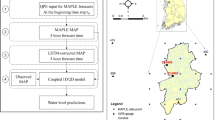Abstract
Real time updating of rainfall-runoff (RR) models is traditionally performed by state-space formulation in the context of flood forecasting systems. In this paper, however, we examine applicability of generalized likelihood uncertainty estimation (GLUE) approach in real time modification of forecasts. Real time updating and parameter uncertainty analysis was conducted for Abmark catchment, a part of the great Karkheh basin in south west of Iran. A conceptual-distributed RR model, namely ModClark, was used for basin simulation, such that the basin’s hydrograph was determined by the superposition of runoff generated by individual cells in a raster-based discretization. In real time updating of RR model by GLUE method, prior and posterior likelihoods were computed using forecast errors that were obtained from the results of behavioral models and real time recorded discharges. Then, prior and posterior likelihoods were applied to modify forecast confidence limits in each time step. Calibration of parameters was performed using historical data while distribution of parameters was modified in real time based on new data records. Two scenarios of rainfall forecast including prefect-rainfall-forecast and no-rainfall-forecast were assumed in absence of a robust rainfall forecast model in the study catchment. The results demonstrated that GLUE application could offer an acceptable lead time for peak discharge forecast at the expense of high computational demand.

















Similar content being viewed by others
Abbreviations
- AK:
-
Loss rate coefficient at the beginning of the time interval
- AL:
-
Potential loss rate in mm/h during the time interval
- C :
-
Accumulated loss (mm)
- d max :
-
Maximum travel distance to the catchment outlet
- DL:
-
Amount of initial accumulated rain loss (mm)
- DK:
-
Incremental increase in the loss rate coefficient during the first DL of accumulated loss
- ER:
-
Exponent of precipitation that reflects the influence of precipitation rate on basin average loss characteristics and varies from 0.0 to 1.0
- L(θ i |Y):
-
Performance measure for i-th model conditioned on the observed discharges of Y
- N :
-
Parameter of equation
- O t :
-
Observed discharge at t time step
- \(\bar O\) :
-
Average observed discharge during flood period
- P :
-
The hourly precipitation in mm
- RK:
-
Corresponding ratio for snow loss
- RL:
-
Ratio of rain loss coefficient that corresponding to 10 mm more of accumulated loss
- Q t :
-
Simulated discharge at time step t
- \(\bar Q\) :
-
Average simulated discharge during flood period
- SR:
-
Start values of rainfall loss coefficients (mm/h)
- SS:
-
Start values of snowmelt loss coefficients (mm/h)
- t c :
-
Concentration time
- w t :
-
Weight of discharge corresponding to time step t
- σ 2obs :
-
Observed variance for the period of flood hydrograph
- η:
-
Scale coefficient for rescaling of the posterior likelihood
References
Aronica G, Bates PD, Horritt MS (2002) Assessing the uncertainty in distributed models predictions using observed binary pattern information with in GLUE. Hydrol Process 16(10):2001–2016
Bates BC, Campbell EP (2001) A Morkov Chain Monte Carlo scheme for parameter estimation and inference in conceptual rainfall-runoff modeling. Water Resour Res 37(4):937–947
Beven KJ (2000) Rainfall-runoff modeling, 1 st edn. Wiley, New York
Beven KJ (2002) Uncertainty and the detection of structural change in models of environmental system. In: Manifesto A, Beck MB (eds) Environmental foresight and models, Chap 12, pp 227–250
Beven KJ, Binley A (1992) The future of distributed models: model calibration and uncertainty prediction. Hydrol Process 6(3):279–298
Beven KJ, Freer J (2001) Equifinality, data assimilation and uncertainty estimation in mechanistic modeling of complex environmental systems using the GLUE methodology. J Hydrol 249:11–29
Brazier RE, Beven KJ, Anthony SG, Rowan JS (2001) Implications of model uncertainty for the mapping of hillslope-scale soil erosion predictions. Earth Surf Process Landforms 26(12):1333–1352
Campbell EP, Fox DR, Bates BC (1999) A Bayesian approach to parameter estimation and pooling in nonlinear flood event models. Water Resour Res 35(1):211–220
Christiaens K, Feyen J (2002) Constraining soil hydraulic parameter and output uncertainty of the distributed hydrological MIKE SHE model using the GLUE framework. Hydrol Process 16(2):373–391
Day GN (1985) Extended stream flow forecasting using NWSRFS. J Water Resour Plan Manage ASCE III:157–170
Feyen L, Beven KJ, De Smedt F, Freer J (2001) Stochastic capture zone delineation within the generalized likelihood uncertainty estimation methodology: conditioning on head observations. Water Resour Res 37(3)625–638
Franks S, Beven KJ (1997) Bayesian estimation of uncertainty in land surface-atmosphere flux predictions. J Geophys Res Atmos 102(D20):23991–23999
Freer J, Beven KJ, Ambroise B (1996) Bayesian estimation of uncertainty in runoff prediction and the value of data: an application of the GLUE approach. Water Resour Res 32(7):2161–2173
Georgakakos KP (1986) A generalized stochastic hydro meteorological model for flood and flash-flood forecasting, 1-formulation. Water Resour Res 22(13):2085–2095
Georgrakakos KP, Bras RL (1982) A precipitation model and its use in real time river flow forecasting. Ralph M. Parsons Laboratory Hydrology and Water Resource System, 301 p
Hankin BG, Hardy R, Kettle H, Beven KJ (2001) Using CFD in a GLUE framework to model the flow and dispersion characteristics of a natural fluvial dead zone. Earth Surf Process Landforms 26(6):667–687
Hunter NM, Bates PD, Horritt MS, De Roo PJ, Werner MGF (2005) Utility of different data types for calibrating flood inundation models within a GLUE framework. Hydrol Earth Syst Sci 9(4):412–430
Hydrologic Engineering Center (1998) HEC1 flood hydrograph package, user’s manual. US Army Crops of Engineers, 283 p
Kitanidis PK, Bras RL (1980) Real-time forecasting with a conceptual hydrologic model: 1. analysis of uncertainty, 2. application and results. Water Resour Res 16(6):1025–1044
Kuczara G, Parent E (1998) Monte Carlo assessment of parameter uncertainty in conceptual catchment models: the Metropolis algorithm. J Hydrol 211:69–85
Kull D, Feldman A (1998) Evolution of Clark’s unit graph method to spatially distributed runoff. J Hydrol Eng ASCE 3(1):9–19
Liu Z, Martina MLV, Todini E (2005) Flood forecasting using a fully distributed model: application of the TOPKAPI model to the upper Xixian catchment. Hydrol Earth Syst Sci 9(4):347–365
Pappenberger F, Beven KJ, Hunter NM, Bates PD, Gouweleeuw BT, Thielen J, De Roo APJ (2005) Cascading model uncertainty from medium range weather forecast (10 day) through a rainfall-runoff model to flood inundation prediction within the European flood forecasting system (EFFS). Hydrol Earth Syst Sci 9(4):381–393
Peters J, Easton D (1996) Runoff simulation using radar rainfall data. Water Resour Bull AWRA 32(4):753–760
Rabuffetti D, Barbero S (2005) Operational hydro-meteorological warning and real-time flood forecasting: the Piemonte Region case study. Hydrol Earth Syst Sci 9(4):394–411
Romanowicz R, Beven KJ (1998) Dynamic real-time prediction of flood inundation probabilities. Hydrol Sci J 43(2):181–196
Schulz K, Beven KJ, Huwe B (1999) Equifinality and the problem of robust calibration in nitrogen budget simulations. Soil Sci Soc Am J 63(6):1934–1941
Author information
Authors and Affiliations
Corresponding author
Rights and permissions
About this article
Cite this article
Heidari, A., Saghafian, B. & Maknoon, R. Assessment of flood forecasting lead time based on generalized likelihood uncertainty estimation approach. Stoch Environ Res Ris Assess 20, 363–380 (2006). https://doi.org/10.1007/s00477-006-0032-y
Published:
Issue Date:
DOI: https://doi.org/10.1007/s00477-006-0032-y




